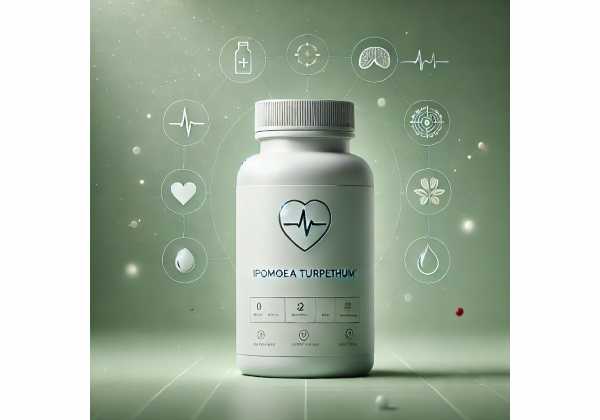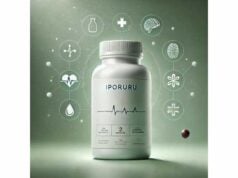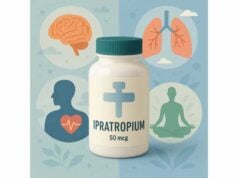
Ipomoea turpethum—also known as Operculina turpethum, trivrit (Ayurveda), or turpeth—is a twining vine whose dried root has been used for centuries as a cleansing purgative and liver-supportive herb. Traditional systems describe it for constipation, edema, skin eruptions, and sluggish digestion. Modern lab and animal studies point to resin glycosides (turpethinic acids), saponins (operculinosides), phytosterols, and coumarins that may underlie antidiarrheal, anti-inflammatory, hepatoprotective, and glucose-modulating actions. Practically, people encounter the plant as powdered root, decoctions, or classical compound formulas aimed at bowel regularity and metabolic balance. Because turpeth is a strong evacuant, correct dose and context matter: too much can cause griping, dehydration, and electrolyte loss. This guide explains what it does, how to use it thoughtfully, who should avoid it, and what the evidence actually shows—so you can discuss options safely with your clinician.
Key Insights
- May support bowel regularity and reduce intestinal spasm; experimental data suggest hepatoprotective and anti-inflammatory effects.
- Primary actives include resin glycosides and saponins; potency varies by preparation and fraction.
- Typical traditional dose for dried root powder: 1–3 g orally; begin low (≈500 mg) to assess response.
- Strong laxative action; avoid during pregnancy, dehydration, bowel obstruction, or active inflammatory bowel disease.
Table of Contents
- What is it and how does it work?
- Benefits and properties backed by evidence
- How to use it in practice
- Dosage, preparations, and timing
- Safety, side effects, and who should avoid it
- Research quality, limits, and what to watch next
What is it and how does it work?
Ipomoea turpethum is a perennial vine in the morning glory family (Convolvulaceae). The medicinal part is the dried root, traditionally sliced, dried, and powdered. In classical texts, trivrit is categorized as a strong shodhana (purifying) drug—used to evacuate the bowel, clear retained fluids, and reduce swelling. Unani medicine lists it as turbud with similar purgative and deobstruent functions. Botanically, it has been reclassified under the genus Operculina; both names are used in modern literature.
The pharmacology centers on resin glycosides—collectively called turpethinic acids—and saponins such as operculinosides, plus phytosterols (e.g., β-sitosterol), triterpenes (lupeol, betulin), and coumarins (scopoletin). Resin glycosides are amphipathic molecules that stimulate intestinal motility and secretion. This mechanism explains the primary effect: a laxative action that, at low to moderate doses, supports bowel clearance and, at higher doses, causes pronounced purgation. Saponins contribute surfactant-like effects on mucosa and cell membranes and show broad anti-inflammatory and hepatoprotective signals in preclinical models. Additional fractions demonstrate antispasmodic effects on intestinal smooth muscle and bronchodilation in isolated tissue studies, suggesting calcium-channel-modulating activity.
From a systems view, three axes describe its actions:
- Evacuant: Increases peristalsis and stool water, loosening hard stools and reducing transit time.
- Hepatoprotective/Detox Support: Preclinical work shows protection against chemical liver injury, likely via antioxidant and anti-inflammatory pathways and modulation of NF-κB signaling.
- Metabolic and GI Comfort: Experimental fractions inhibit carbohydrate-digesting enzymes and reduce cramps via antispasmodic activity.
Quality varies widely. Root age, harvesting season, drying, and extraction solvent all influence resin content and potency. Correct botanical identity matters; other Ipomoea/Operculina species differ in resin profiles. Because the herb is strong, traditional practice pairs it with demulcents (ginger, licorice, ghee) to reduce griping and with electrolyte fluids when used for purgation.
In short: Ipomoea turpethum is not a gentle daily fiber; it’s a potent evacuant with ancillary liver and anti-inflammatory signals, best used intentionally and in the right clinical scenarios.
Benefits and properties backed by evidence
Bowel regularity and evacuation. The best-established property is laxation. Resin glycosides increase intestinal secretion and motility, moving hard stools and reducing bloating from slow transit. Traditional dosing differentiates between mild bowel assistance (small, titrated amounts) and therapeutic purgation (higher doses for short, supervised courses). People often report onset within several hours, with watery stools if dose is excessive.
Antidiarrheal and antispasmodic paradox. Plants can show biphasic GI effects depending on fraction and dose. Crude extracts of Ipomoea turpethum demonstrate antispasmodic activity on isolated intestinal tissue and reduce castor-oil–induced diarrhea in animal models, likely through calcium-channel antagonism. Clinically, this suggests that smaller, specific fractions (rather than whole resin-rich root) may calm spasms, whereas resin-rich preparations promote evacuation. This distinction underscores the importance of preparation choice.
Hepatoprotective effects. Multiple animal studies demonstrate protection against chemically induced liver injury, with improvements in transaminases, lipid peroxidation, and histopathology. Proposed mechanisms include down-regulation of pro-inflammatory mediators and oxidative stress pathways. While promising, these findings remain preclinical; no large human trials verify liver outcomes.
Metabolic markers. Fractionation studies—especially flavonoid-rich fractions—show inhibitory effects on carbohydrate-digesting enzymes in vitro and modest glycemic benefits in rodent models. These signals are hypothesis-generating, not definitive for humans, but they align with traditional uses for “kapha” or metabolic heaviness.
Respiratory smooth muscle effects. Isolated tissue experiments show bronchodilatory actions; historically, some formulations included turpeth in respiratory congestion patterns where purgation was also desired. This is not a substitute for standard asthma therapy; at most, it is an explanatory note on smooth-muscle pharmacology.
Dermatologic and fluid-retention patterns. Traditional indications include congestive states with edema or skin eruptions aggravated by constipation. Mechanistically, purgation can transiently reduce body water, but this is not a treatment for chronic edema or skin disease in isolation. Any dermatologic benefit likely operates indirectly through bowel clearance and inflammatory signaling, not through targeted dermatologic pathways.
Overall, Ipomoea turpethum has strong traditional support and moderate preclinical evidence for its GI, hepatic, and smooth-muscle effects. Human clinical data are limited, so benefit claims for metabolic or long-term liver support should be framed as preliminary. For individuals primarily seeking a gentle, daily laxative, fiber, magnesium, or senna-based teas may be more appropriate; turpeth is reserved for cases where a firm “push” is indicated and supervised.
How to use it in practice
Choose the right form for your goal:
- Mild bowel assistance: Opt for standardized root powders with lower resin content, or traditional churnas blended with demulcents. Start low and adjust.
- Therapeutic purgation (short course): Classical protocols combine powdered root with warming carminatives (e.g., ginger) and a lipid vehicle (ghee) to reduce cramping, administered once under supervision with rehydration planning.
- Targeted effects (antispasmodic or metabolic research aims): Some modern extracts focus on specific fractions (flavonoid, saponin). These are experimental and not uniform across brands; labeling should disclose fraction type and extract ratio.
Supportive measures increase comfort and safety:
- Hydration and electrolytes: Take with warm water; if stools become watery, add oral rehydration solution (ORS) and reduce/hold the next dose.
- Meal timing: Traditionally taken on an empty stomach in the morning for purgation; for milder support, small bedtime doses may help with morning bowel movements.
- Adjuncts: Demulcents (licorice, slippery elm) or ginger can lessen griping. Avoid co-administration with other stimulant laxatives to prevent over-purging.
Who might consider it (with clinician input):
- Individuals with occasional, stubborn constipation unresponsive to fiber/osmotics and who prefer a herbal purgative experience.
- Short-term bowel clearance within traditional protocols when supervised.
- Research contexts exploring metabolic or hepatic endpoints (not routine self-care).
Quality tips:
- Verify botanical identity (Operculina turpethum syn. Ipomoea turpethum).
- Prefer suppliers that provide contaminant testing (heavy metals, microbial counts) and extract specification (e.g., resin or saponin content).
- Store powders in an airtight container away from moisture; resinous roots can degrade with humidity.
Red flags that signal stopping and reassessment: persistent cramping, dizziness, signs of dehydration, blood in stool, or diarrhea lasting more than 24 hours after dosing. In such cases, discontinue and consult a clinician.
Dosage, preparations, and timing
Traditional powdered root (single herb):
- Typical adult oral range: 1–3 g of dried root powder once daily, taken with warm water or mixed with a vehicle (ghee/honey) to temper griping.
- Initiation strategy: Begin at ≈500 mg to evaluate sensitivity. Increase by 250–500 mg as needed, not exceeding the upper range unless under professional supervision.
- Onset: 2–8 hours for bowel movement; faster on an empty stomach with warm liquids.
Extracts and fractions:
- Standardized extracts vary (e.g., 10:1). A cautious starting point is 100–200 mg extract once daily, titrating based on response and labeling guidance. For fractionated products (flavonoid/saponin), follow manufacturer guidance; research doses in animals do not translate 1:1 to humans.
Decoction (classical):
- Simmer 3–5 g coarse root in 250–300 ml water to reduce by one-third; strain. This is stronger than powder for many users. Start lower if sensitive.
Short-course purgation protocol (traditional, supervised):
- A single morning dose in the 2–5 g range with a warming vehicle, followed by scheduled warm fluids and ORS; plan a low-residue diet for the day. This is not routine self-care and should be clinician-guided.
Co-supplement considerations:
- Separate from electrolyte-depleting diuretics or digitalis-like drugs.
- Space other oral medications by 3–4 hours, as rapid transit may reduce absorption.
- Do not combine with other stimulant laxatives (senna, cascara) unless specifically directed.
When to use less: elderly or frail individuals, those with low baseline blood pressure, or anyone prone to dehydration. In these cases, consider alternatives (bulk fiber, magnesium citrate/glycinate) and reserve turpeth for occasional, supervised use.
Pediatric use: not recommended without specialist guidance; strong purgatives can cause fluid and electrolyte shifts in children.
Pregnancy and lactation: avoid; classical texts and modern safety standards advise against strong purgatives in these settings.
Safety, side effects, and who should avoid it
Common, dose-related effects: loose stools, abdominal cramping, urgency, nausea, flatulence. These often reflect excessive dosing or taking resin-rich preparations without a demulcent vehicle. Reducing the dose, adding ginger or licorice, and ensuring warm fluids usually improve tolerance.
Dehydration and electrolyte imbalance: watery stools can lower potassium and sodium. Warning signs include muscle cramps, lightheadedness, palpitations, and dark urine. Respond with ORS, pause further dosing, and reassess whether the herb is appropriate.
GI contraindications: bowel obstruction, acute abdomen, appendicitis suspicion, active inflammatory bowel disease flare, severe hemorrhoids/fissures with bleeding, or chronic diarrhea.
Pregnancy and postpartum: avoid due to uterine and GI stimulation and dehydration risk. During lactation, strong purgatives are generally avoided unless specifically prescribed; gentler options are preferred.
Drug interactions:
- Diuretics or corticosteroids: compounded potassium loss.
- Cardiac glycosides: electrolyte shifts can increase arrhythmia risk.
- Oral drugs with narrow therapeutic windows: faster transit may reduce absorption; separate by several hours.
Allergy and contamination: rare plant allergy is possible. As with many botanicals, the main practical risks are adulteration or contamination (e.g., heavy metals). Buy from suppliers that provide third-party testing and clear batch data.
Toxicology snapshot: animal studies using root extracts and modern nanoparticle carriers report no acute oral toxicity at high experimental doses, with routine hematology and histology within normal limits. This supports a reasonable safety margin when used appropriately, but it does not override the clinical reality that purgation is physiologically taxing. Respect the dose, and don’t use it as a daily habit.
Stop and seek care immediately for: blood in stool, persistent vomiting, fainting, chest pain, or severe abdominal pain unrelieved by bowel movements.
Research quality, limits, and what to watch next
Most evidence for Ipomoea turpethum comes from preclinical work: in vitro assays, isolated tissue studies, and rodent models of intestinal motility, liver injury, and carbohydrate metabolism. These studies consistently show biologic activity of resin glycosides and saponin fractions, including antispasmodic, hepatoprotective, anti-inflammatory, and antidiarrheal effects (depending on dose and fraction). Importantly, human trials are scarce and small; we lack robust randomized studies comparing turpeth to standard laxatives, osmotic agents, or prokinetics on endpoints like stool frequency, Bristol scale, or quality of life.
The literature also reveals fraction-dependent effects. Whole-root preparations rich in resin glycosides act as stimulant/osmotic laxatives. Fractionated extracts (e.g., flavonoid-rich) may reduce spasms or modulate glycemia—suggesting that future standardized products could target narrower indications with fewer GI side effects. Another theme is signaling modulation (e.g., NF-κB down-regulation) that might explain anti-inflammatory profiles, including hepatoprotection in toxicant models.
Safety research is improving, with acute oral toxicity assessments—including novel delivery systems—showing wide margins in animals. That said, clinical safety hinges on hydration and context. A plant can be “non-toxic” in lab terms yet still cause harm if misused as a strong laxative over days to weeks.
What to watch next:
- Human RCTs comparing low-dose turpeth powder vs. magnesium or senna for occasional constipation.
- Standardized fraction trials for antispasmodic effects in IBS-D/IBS-M, focusing on pain and urgency rather than evacuation.
- Liver outcomes in non-alcoholic fatty liver disease or toxicant exposures—only if powered and paired with standard care.
- Quality standards harmonizing resin/saponin content, pesticide/heavy-metal testing, and label transparency.
- Patient-reported outcomes (bloating, urgency, cramping) to define who actually benefits in real-world use.
Until such data arrive, the practical stance is conservative: reserve Ipomoea turpethum for occasional, guided use when a decisive purge is indicated, or within traditional protocols overseen by qualified practitioners, not as a routine daily supplement.
References
- Operculina turpethum (Linn.) Silva Manso as a Medicinal Plant Species: A Review on Bioactive Components and Pharmacological Properties 2017 (Systematic Review)
- Studies on antidiarrhoeal, antispasmodic and bronchodilator activities of Operculina turpethum Linn. 2014 (Preclinical)
- Attenuation of N-nitrosodimethylamine induced hepatic damage by Operculina turpethum in mice 2014 (Preclinical)
- Ameliorative potential of Operculina turpethum against diabetes: In vitro and in vivo studies 2021 (Preclinical)
- Evaluation of acute oral toxicity of Ipomoea turpethum extract loaded polymeric nanoparticles in Wistar rats 2023 (Toxicology)
Disclaimer
This article is for educational purposes and does not replace personalized medical advice, diagnosis, or treatment. Ipomoea turpethum is a potent purgative. Discuss use, dosing, interactions, and alternatives with a qualified healthcare professional—especially if you are pregnant, breastfeeding, have chronic illness, take prescription medications, or have digestive disorders. If you experience severe symptoms after taking any herbal product, seek medical care promptly.
If you found this guide useful, consider sharing it on Facebook, X (formerly Twitter), or your favorite platform, and follow us for more evidence-informed herbal profiles. Your support helps us keep producing careful, high-quality content.










